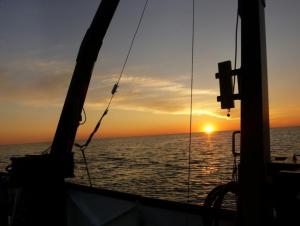

At the Great Lakes Center’s recent open house, director Alexander Karayatev discussed the center’s funded research projects. As the center grows, its studies of Lake Erie, its tributaries, and its ecology become increasingly significant.
Karatayev reported that the center currently has 13 full-time employees, including scientists, faculty members, research technicians, field station personnel, and support staff. The center also employs research assistants, many of them undergraduate and graduate students from Buffalo State and the University at Buffalo. The Western New York Partnership for Regional Invasive Species Management (PRISM), a sponsored program funded by the New York State Department of Environmental Conservation (NYS DEC) through the Research Foundation, is also administered by the center. It hired eight seasonal employees in summer 2015.
Karatayev cited multiple accomplishments, chief among them the growing reputation the center has achieved since 2007. “We have become much better known,” he said, “and we have brought in many speakers and sponsored professional workshops. We have collaborated with more than 80 scientists, and our grant funding has increased tenfold since 2007–2008.” The center is involved in projects funded for $9.2 million dollars, with $4.8 million for Buffalo State.
Research Focuses on Freshwater Fish, Mollusks, and Great Lakes Monitoring
 Current research projects headed by scientists at the center include two with significant implications for Western New York’s sports fishing industry. One study focuses on the emerald shiner, a small fish that plays an important role in supporting not only sports fish such as walleye and small- and largemouth bass but also birds such as loons and the threatened common tern. Another study focuses on the sturgeon population in the lower Niagara River—one of the few remnant populations of lake sturgeon in the lower Great Lakes. Scientists are studying their habitat, their feeding ecology, and the resources available to them in the benthic zone (the area on, near, or below the bottom of the river and the aquatic species that live there).
Current research projects headed by scientists at the center include two with significant implications for Western New York’s sports fishing industry. One study focuses on the emerald shiner, a small fish that plays an important role in supporting not only sports fish such as walleye and small- and largemouth bass but also birds such as loons and the threatened common tern. Another study focuses on the sturgeon population in the lower Niagara River—one of the few remnant populations of lake sturgeon in the lower Great Lakes. Scientists are studying their habitat, their feeding ecology, and the resources available to them in the benthic zone (the area on, near, or below the bottom of the river and the aquatic species that live there).
Among the most important current research projects is the long-term monitoring of the Great Lakes. Karatayev, Lyubov Burlakova, a senior research scientist at the center, and their associates have traveled with a team aboard the U.S. EPA research vessel Lake Guardian conducting a long-term monitoring program funded by the EPA. The center’s field station, headed by Mark Clapsadl, has been operating an observation buoy in eastern Lake Erie since 2012 as part of the Great Lakes Observation System. Clapsadl thanked the NYS DEC for its assistance in deploying and retrieving the buoy.
Conference Drew International Scientists to Buffalo
 Karatayev and Burlakova, internationally recognized experts in freshwater mussels, and Knut Mehler, a research scientist, were instrumental in bringing the second International Meeting on Biology and Conservation of Freshwater Bivalves to Buffalo in October. Burlakova is currently heading a committee exploring greater cooperation between the Freshwater Mollusk Conservation Society, based in North America, and its European counterparts.
Karatayev and Burlakova, internationally recognized experts in freshwater mussels, and Knut Mehler, a research scientist, were instrumental in bringing the second International Meeting on Biology and Conservation of Freshwater Bivalves to Buffalo in October. Burlakova is currently heading a committee exploring greater cooperation between the Freshwater Mollusk Conservation Society, based in North America, and its European counterparts.
The center’s graduate programs, including a professional science master’s program, are meeting enrollment expectations and attracting students from outside Western New York.
“We are succeeding in increasing our research, our funding, our cooperation with area agencies and community organizations, and expanding opportunities for hands-on experience for students at Buffalo State, UB, and other institutions,” said Karatayev. “I think we are in a good position to begin preparations for celebrating the center’s 50th anniversary next year.”
Some content on this page is saved in PDF format. To view these files, download Adobe Acrobat Reader free. If you are having trouble reading a document, request an accessible copy of the PDF or Word Document.
